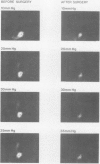Abstract
Thirty-six (36) patients with symptomatic gastroesophageal reflux were studied. Symptoms of heartburn, regurgitation and dysphagia were scored as to their severity and compared to quantitative tests of gastroesophageal reflux. Patients were studied with the acid reflux test, fiberoptic endoscopy, esophageal mucosal biopsy with a pinch forceps, esophageal manometry and radioisotopic gastroesophageal scintigraphy. Symptoms were scored according to an arbitrary grading system as mild, moderate, or severe. There were significant correlations between symptoms scores and both the degree of endoscopic esophagitis and the gastroesophageal reflux indices as measured by the radioisotopic scintiscan, but not with the degree of histologic esophagitis or lower esophageal sphincter pressure. Review of the findings suggests the following profile for patients who might require antireflux surgery: severe symptoms, presence of endoscopic esophagitis; resting lower esophageal sphincter pressure below 10 mmHg; and gastroesophageal reflux index above 10%.
Full text
PDF





Images in this article
Selected References
These references are in PubMed. This may not be the complete list of references from this article.
- Bahadorzadeh K., Jordan P. H., Jr Evaluation of the Nissen fundoplication for treatment of hiatal hernia: use of parietal cell vagotomy without drainage as an adjunctive procedure. Ann Surg. 1975 Apr;181(4):402–408. doi: 10.1097/00000658-197504000-00006. [DOI] [PMC free article] [PubMed] [Google Scholar]
- Battle W. S., Nyhus L. M., Bombeck C. T. Nissen fundoplication and esophagitis secondary to gastroesophageal reflux. Arch Surg. 1973 Apr;106(4):588–592. doi: 10.1001/archsurg.1973.01350160200035. [DOI] [PubMed] [Google Scholar]
- Benz L. J., Hootkin L. A., Margulies S., Donner M. W., Cauthorne R. T., Hendrix T. R. A comparison of clinical measurements of gastroesophageal reflux. Gastroenterology. 1972 Jan;62(1):1–5. [PubMed] [Google Scholar]
- Brennan T. G., Trindade L. M., Rozycki Z. J., Giles G. R. The influence of the lower oesophageal sphincter pressure on the outcome of hiatus hernia repair. Br J Surg. 1974 Mar;61(3):201–205. doi: 10.1002/bjs.1800610308. [DOI] [PubMed] [Google Scholar]
- Edwards D. A. Symposium on gastrooesophageal reflux and its complications. 1. Definitions, the antireflux mechanism, and symptoms. Gut. 1973 Mar;14(3):233–237. doi: 10.1136/gut.14.3.233. [DOI] [PMC free article] [PubMed] [Google Scholar]
- Fisher R. S., Malmud L. S., Roberts G. S., Lobis I. F. Gastroesophageal (GE) scintiscanning to detect and quantitate GE reflux. Gastroenterology. 1976 Mar;70(3):301–308. [PubMed] [Google Scholar]
- Fisher R. S., Malmud L. S., Roberts G. S., Lobis I. F. The lower esophageal sphincter as a barrier to gastroesophageal reflux. Gastroenterology. 1977 Jan;72(1):19–22. [PubMed] [Google Scholar]
- Hattori K., Winans C. S., Archer F., Kirsner J. B. Endoscopic diagnosis of esophageal inflammation. Gastrointest Endosc. 1974 Feb;20(3):102–104. doi: 10.1016/s0016-5107(74)73895-0. [DOI] [PubMed] [Google Scholar]
- Hill L. D. An effective operation for hiatal hernia: an eight year appraisal. Ann Surg. 1967 Oct;166(4):681–692. doi: 10.1097/00000658-196710000-00015. [DOI] [PMC free article] [PubMed] [Google Scholar]
- Ismail-Beigi F., Horton P. F., Pope C. E., 2nd Histological consequences of gastroesophageal reflux in man. Gastroenterology. 1970 Feb;58(2):163–174. [PubMed] [Google Scholar]
- Ismail-Beigi F., Pope C. E., 2nd Distribution of the histological changes of gastroesophageal reflux in the distal esophagus of man. Gastroenterology. 1974 Jun;66(6):1109–1113. [PubMed] [Google Scholar]
- Lipshutz W. H., Eckert R. J., Gaskins R. D., Blanton D. E., Lukash W. M. Normal lower-esophageal-sphincter function after surgical treatment of gastroesophageal reflux. N Engl J Med. 1974 Nov 21;291(21):1107–1110. doi: 10.1056/NEJM197411212912104. [DOI] [PubMed] [Google Scholar]
- Orringer M. B., Skinner D. B., Belsey R. H. Long-term results of the Mark IV operation for hiatal hernia and analyses of recurrences and their treatment. J Thorac Cardiovasc Surg. 1972 Jan;63(1):25–33. [PubMed] [Google Scholar]
- PETERS P. M. The pathology of severe digestion oesophagitis. Thorax. 1955 Dec;10(4):270–286. doi: 10.1136/thx.10.4.269. [DOI] [PMC free article] [PubMed] [Google Scholar]
- Pope C. E., 2nd A dynamic test of sphincter strength: its application to the lower esophageal sphincter. Gastroenterology. 1967 May;52(5):779–786. [PubMed] [Google Scholar]
- TUTTLE S. G., GROSSMAN M. I. Detection of gastro-esophageal reflux by simultaneous measurement of intraluminal pressure and pH. Proc Soc Exp Biol Med. 1958 Jun;98(2):225–227. doi: 10.3181/00379727-98-23998. [DOI] [PubMed] [Google Scholar]
- Ward A. S., Wright D. H., Collis J. L. The assessment of oesophagitis in hiatus hernia patients. Thorax. 1970 Sep;25(5):568–572. doi: 10.1136/thx.25.5.568. [DOI] [PMC free article] [PubMed] [Google Scholar]



